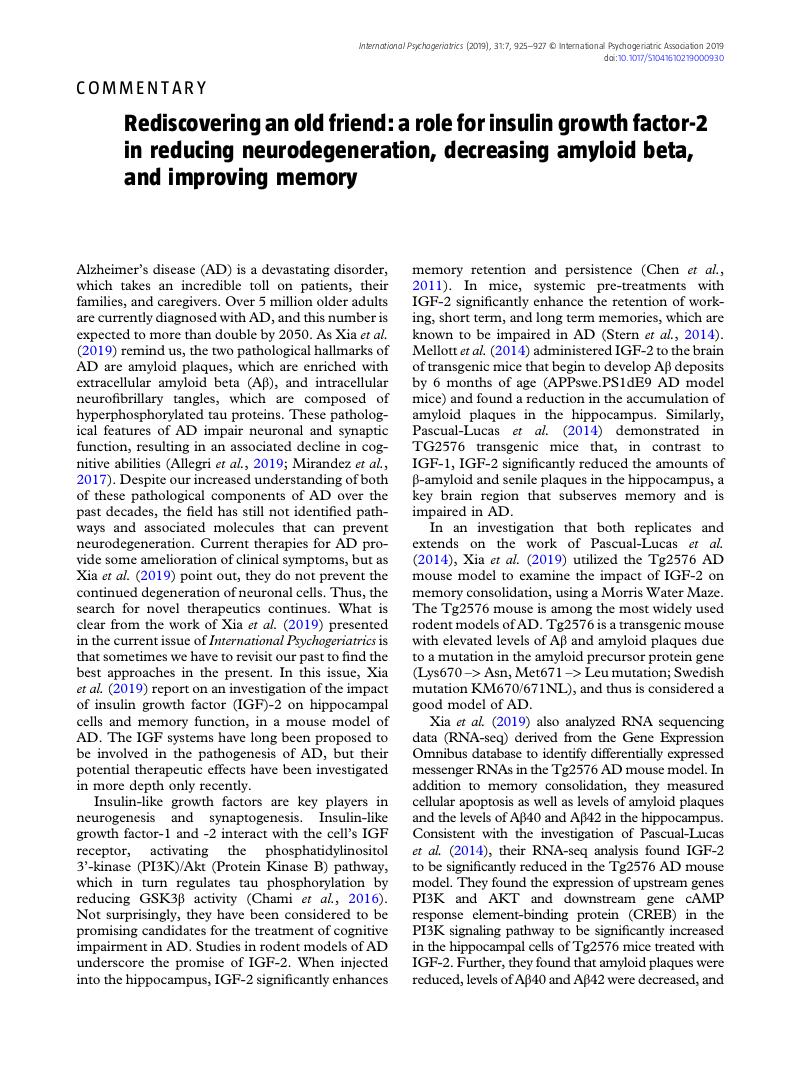No CrossRef data available.
Article contents
Rediscovering an old friend: a role for insulin growth factor-2 in reducing neurodegeneration, decreasing amyloid beta, and improving memory
Published online by Cambridge University Press: 09 August 2019
Abstract
An abstract is not available for this content so a preview has been provided. Please use the Get access link above for information on how to access this content.

- Type
- Commentary
- Information
- International Psychogeriatrics , Volume 31 , Issue 7: Issue Theme: Diverse Approaches to Stemming Cognitive Decline , July 2019 , pp. 925 - 927
- Copyright
- © International Psychogeriatric Association 2019
References
Åberg, D. et al. (2015). Increased cerebrospinal fluid level of insulin-like growth factor-II in male patients with Alzheimer’s disease. Journal of Alzheimer’s Disease, 48, 637–646.CrossRefGoogle ScholarPubMed
Allegri, R. F. et al. (2019). A biological classification for Alzheimer’s disease—Amyloid, Tau and Neurodegeneration (A/T/N): results from the Argentine-Alzheimer’s Disease Neuroimaging Initiative. International Psychogeriatrics. doi: 10.1017/S1041610219000085.CrossRefGoogle ScholarPubMed
Chami, B., Steel, A. J., De La Monte, S. M. and Sutherland, G. T. (2016). The rise and fall of insulin signaling in Alzheimer’s disease. Metabolic Brain Disease, 31, 497–515.CrossRefGoogle ScholarPubMed
Chen, D. Y. et al. (2011). A critical role for IGF-II in memory consolidation and enhancement. Nature, 469, 491–497.CrossRefGoogle ScholarPubMed
Duron, E. et al. (2012). Insulin-like growth factor-I and insulin-like growth factor binding protein-3 in Alzheimer’s disease. The Journal of Clinical Endocrinology & Metabolism, 97, 4673–4681.CrossRefGoogle ScholarPubMed
Hanyu, H. (2019). Diabetes-related dementia. Advances in Experimental Medicine and Biology, 1128, 147–160.CrossRefGoogle ScholarPubMed
Hawkes, C., Jhamandas, J. H., Harris, K. H., Fu, W., MacDonald, R. G. and Kar, S. (2006). Single transmembrane domain insulin-like growth factor-II/mannose-6-phosphate receptor regulates central cholinergic function by activating a G-protein-sensitive, protein kinase C-dependent pathway. The Journal of Neuroscience, 26, 585–596.CrossRefGoogle ScholarPubMed
Kita, Y., Ago, Y., Takano, E., Fukada, A., Takuma, K. and Matsuda, T. (2013). Galantamine increases hippocampal insulin-like growth factor 2 expression via 7 nicotinic acetylcholine receptors in mice. Psychopharmacology, 225, 543–551.CrossRefGoogle Scholar
Knusel, B., Michel, P. P., Schwaber, J. S. and Hefti, F. (1990). Selective and nonselective stimulation of central cholinergic and dopaminergic development in vitro by nerve growth factor, basic fibroblast growth factor, epidermal growth factor, insulin and the insulin-like growth factors I and II. The Journal of Neuroscience, 10, 558–570.CrossRefGoogle ScholarPubMed
Martin-Montañez, E. et al. (2014). Involvement of IGF-II receptors in the antioxidant and neuroprotective effects of IGF-II on adult cortical neuronal cultures. Biochimica et Biophysica Acta, 1842, 1041–1051.CrossRefGoogle ScholarPubMed
Mellott, T. J., Pender, S. M., Burke, R. M., Langley, E. A. and Blusztajn, J. K. (2014). IGF2 ameliorates amyloidosis, increases cholinergic marker expression and raises BMP9 and neurotrophin levels in the hippocampus of the APPswePS1dE9 Alzheimer’s disease model mice. PLoS One, 9, e9428.CrossRefGoogle ScholarPubMed
Mirandez, R. M., Aprahamian, I., Talib, L. L., Forlenza, O. V. and Radanovic, M. (2017). Multiple category verbal fluency in mild cognitive impairment and correlation with CSF biomarkers for Alzheimer’s disease. International Psychogeriatrics, 29, 949–958.CrossRefGoogle ScholarPubMed
Pardo, M. et al. (2018). Insulin growth factor 2 (IGF2) as an emergent target in psychiatric and neurological disorders. Review. Neuroscience Review, pii: S0168-0102(18)30435-8.Google ScholarPubMed
Pascual-Lucas, M. et al. (2014). Insulin-like growth factor 2 reverses memory and synaptic deficits in APP transgenic mice. EMBO Molecular Medicine, 6, 1246–1262.CrossRefGoogle ScholarPubMed
Shahmoradi, A., Radyushkin, K. and Rossner, M. J. (2015). Enhanced memory consolidation in mice lacking the circadian modulators Sharp1 and -2 caused by elevated IGF2 signaling in the cortex. Proceedings of the National Academy of Sciences of the United States of America, 112, E3582–E3589.CrossRefGoogle ScholarPubMed
Steen, E. et al. (2005). Impaired insulin and insulin-like growth factor expression and signaling mechanisms in Alzheimer's disease--is this type 3 diabetes? Journal of Alzheimer’s Disease, 7, 63–80.CrossRefGoogle ScholarPubMed
Stern, S. A., Chen, D. Y. and Alberini, C. M. (2014). The effect of insulin and insulin-like growth factors on hippocampus- and amygdala-dependent long-term memory formation. Learning & Memory, 21, 556–563.CrossRefGoogle ScholarPubMed
Wennberg, A. M. et al. (2014). Diabetes and cognitive outcomes in a nationally representative sample: the National Health and Aging Trends Study. International Psychogeriatrics, 26, 1729–1735.CrossRefGoogle Scholar
Xia, L. et al. (2019). Genome-wide RNA sequencing analysis reveals that IGF-2 attenuates memory decline, oxidative stress and amyloid plaques in Alzheimer’s disease mouse model (AD) by activating the PI3K/AKT/CREB signaling pathway. International Psychogeriatrics, 31, 947–959. doi: 10.1017/S1041610219000383.Google Scholar




